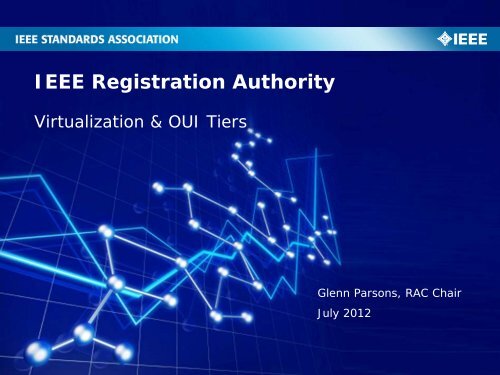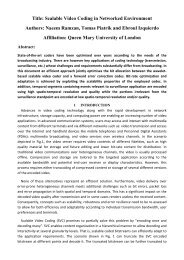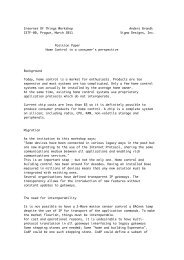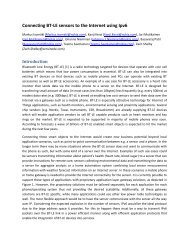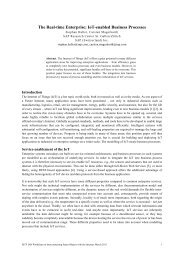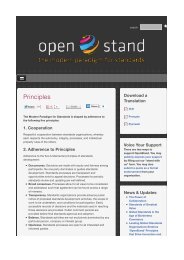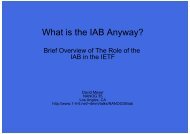IEEE RAC
IEEE RAC
IEEE RAC
You also want an ePaper? Increase the reach of your titles
YUMPU automatically turns print PDFs into web optimized ePapers that Google loves.
<strong>IEEE</strong> Registration Authority<br />
Virtualization & OUI Tiers<br />
Glenn Parsons, <strong>RAC</strong> Chair<br />
July 2012
<strong>RAC</strong> Members<br />
• Glenn Parsons, Chair<br />
• Geoff Thompson, (LMSC prime) <strong>IEEE</strong> 802<br />
• Clint Chaplin, (LMSC alternate) <strong>IEEE</strong> 802<br />
• Bob Davis, (MSC prime)<br />
• Leonard Tsai, (MSC alternate)<br />
• Tom Kurihara, (VTS / ITS prime) <strong>IEEE</strong> 1609<br />
• Geoffrey Garner , (I&M prime) <strong>IEEE</strong> 1588<br />
• George Riley, ex-officio (CS SAB)<br />
Staff<br />
– Angela Thomas, <strong>RAC</strong> Secretary<br />
– Karen Lambert, Registrar<br />
2
<strong>RAC</strong> Mission<br />
• The <strong>IEEE</strong> Registration Authority Committee (<strong>IEEE</strong><br />
<strong>RAC</strong>) is the oversight committee for the <strong>IEEE</strong><br />
Registration Authority.<br />
– OUI, OUI-36, IAB, Ethertype, 802.16 BID<br />
– LLC, <strong>IEEE</strong> OID, 1451.4 Mfg ID, 1609.12 PSID<br />
• The <strong>IEEE</strong> <strong>RAC</strong> is international in scope, assisting<br />
standard developing organizations in their<br />
establishment of unambiguous, sustainable<br />
registration authorities.<br />
• The <strong>IEEE</strong> <strong>RAC</strong> considers the long-term interests of<br />
the ultimate users of these standards, while<br />
pragmatically addressing the needs of the affected<br />
organizations, industries, and the <strong>IEEE</strong>.<br />
3<br />
7/24/2012
Current <strong>RAC</strong> Policy on virtualization<br />
• A "prime directive" of the <strong>RAC</strong> is to not run out of global<br />
EUI-48 (aka MAC-48) addresses for 100 years<br />
– OUIs sold – in 2011: 1386 all time: 16390<br />
– If linear – more than 99% left, 4000 year supply<br />
– If growth trend from last few years continues, it is not linear,<br />
26 years left<br />
– What is causing and/or could cause the growth?<br />
• Only one (or at most a few) global EUI-48 addresses can<br />
be assigned to a single hardware device<br />
– This is apparently being violated by existing VM vendors<br />
– ~260 billion EUI-48 (of ~70 trillion possible) addresses have<br />
been assigned – but are they all used?<br />
• One OUI (16M EUI-48 addresses) will be issued per<br />
customer for VM use until a further VM policy is decided<br />
What virtualization policy would reduce consumption of EUI-48 addresses?
Is virtualization the problem?<br />
Ask these questions to ourselves and to vendors in<br />
the VM space to understand the requirements:<br />
1. Should an EUI-48 be the network identifier for<br />
VM, equivalent to an EUI-48 on a physical<br />
machine?<br />
2. If so, should the EUI-48 be from the local or<br />
global address space?<br />
3. Should the address be globally unique forever<br />
or reusable?<br />
4. Should the <strong>RAC</strong> enforce this?
Some responses<br />
1. Should an EUI-48 be the network identifier for VM,<br />
equivalent to an EUI-48 on a physical machine?<br />
• Yes, in the short term<br />
• Maybe not in the long term (beyond 5 years)<br />
2. If so, should the EUI-48 be from the local or global<br />
address space?<br />
• Local space to be consistent<br />
• Global space to ensure non-overlap of multi-vendor<br />
3. Should the address be globally unique forever or<br />
reusable?<br />
• Reusable, as most are doing this already despite collisions<br />
4. Should the <strong>RAC</strong> enforce this?<br />
• Recommend only<br />
• Perhaps the data center should buy address instead of VM<br />
vendor
Suggested Solutions?<br />
• Allow assignment of EUI-48 address to VMs<br />
– Concern that address space will exhaust faster<br />
• Lease, instead of sell, an OUI-based address block<br />
– Or sell to data center (at various granularities) instead of VM<br />
vendor?<br />
• Assign OUI address blocks for VM applications (for either<br />
or both of the local and global address space) and allow<br />
them to be reusable<br />
– If in the global space, concern that this will dilute the value<br />
of EUI-48<br />
• Create a DHCP-like mechanism to allow dynamic<br />
assignment of EUI-48 addresses<br />
– Force deprecation of random EUI-48 assignment<br />
• Create a new “EUI-128” identifier for VMs<br />
– Virtualization is software so a new address may be feasible in<br />
the long term
New Proposed OUI-based Registries<br />
• OUI<br />
• OUI-36<br />
existing<br />
existing<br />
• CompanyID-24<br />
• CompanyID-36<br />
• Addresses-A (48 bit)<br />
• Addresses-B (36 bit)<br />
• Addresses-C (28 bit)<br />
• Addresses-D (24 bit)<br />
Registry EUI48 EUI64<br />
Addresses-A 1 65536<br />
Addresses-B<br />
OUI36<br />
Addresses-C 1048576<br />
Addresses-D<br />
OUI<br />
4096 268435456<br />
~1 million<br />
16777216<br />
~16 million<br />
~270 million<br />
68719476736<br />
~69 billion<br />
1099511627776<br />
~1 trillion
OUI-based registries reorganization<br />
• Key Identifiers<br />
1. 24 bit Company ID<br />
2. 36 bit Company ID<br />
3. 48 bit EUI-48 address<br />
4. 64 bit EUI-64 address<br />
• Existing Registries<br />
– OUI : 1, 3, 4<br />
– OUI-36: 2, 3, 4<br />
• New Registries:<br />
– Addresses Size A: 3, 4<br />
– Addresses Size B: 3, 4<br />
– Addresses Size C: 3, 4<br />
– Addresses Size D: 3, 4<br />
– Company ID 24 bit: 1<br />
– Company ID 36 bit: 2<br />
• Addresses registries<br />
– Do not include company ID<br />
assignment, they are<br />
reserved<br />
• Company ID registries<br />
– Do not include address<br />
assignments<br />
• Pro<br />
– Retains current registries<br />
– Adds granularity to reduce<br />
potential “lost” addresses<br />
– Adds Company ID separation<br />
– Simplifies naming of<br />
registries<br />
• Con<br />
– Separate Company ID<br />
registry (that cannot be used<br />
to create addresses) may be<br />
confusing<br />
– A lot of granularity
Your input is requested<br />
10


